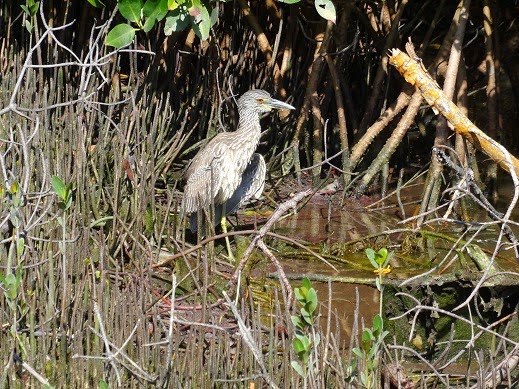As I recall, roughly half the people who panned my favorite place on earth showed up on the one day a week that it is closed; the other half simply didn't see anything that thrilled them. The thrill you get from seeing birds at a wildlife refuge is directly proportional to several things, including (in no particular order): the quality of your knowledge about what you're seeing, the quality of your optics, and the amount of patience you have. I was going to say that it also depends on a strong element of chance or luck, which is true, except that if you know what to look for and choose wisely based on the tides and time of day, then your so-called "luck" increases greatly with your patience.
We're still working to improve our optics, and we're still learning about the birds and their behavior (the Audubon Society lecture was really helpful, especially with reference to special traits to look for now, during the breeding season). But what we lack in equipment and knowledge, we generally make up for in patience and persistence, and my dad and I had a few really good sightings today when we biked in.
Even when you visit a wildlife refuge that is teeming with wildfowl, it is not always easy to actually see the birds. They may be hiding in the shadows, in among the mangroves, or simply too far away for the naked eye to clearly distinguish them.
If you want to see birds of prey, you generally want to look at the upper branches of dead trees on the far side of the water. You're looking for a dark lump on the branch.
 |
| Turkey vulture |
 |
| Of course, now and then a bird will be up close and personal... |
With respect to yellow-crowned night herons, these tend to be relatively shy birds that stick to the margins and the safety of the mangroves. But you can sometimes see them if they happen to be moving, or if you spot the flash of an eye which is less well camouflaged than the rest of the bird...
 |
| Let's play "spot the immature yellow-crowned night heron"! |
 |
| Yep, that's it! |
 |
| Preening |
 |
| "Maybe if I'm really, really quiet, they'll go away." |
 |
| "Here's looking at you, kid!" |
 |
| Ready for a quiet exit... |
When we got to the gazebo at the cross-dike bike path, we saw a tricolor heron resting on a branch. The tricolors are usually quite active, and I happen to love watching them hunt, but they are not so rare that one need necessarily ogle them for ages when they're just standing around.
So I was looking at the tricolor and looking around, and a couple that was already there pointed out a green heron on a branch. Even with their assistance, it took a while to actually see it. This was very exciting for us. We seldom see green herons; they seem to be even more shy (or perhaps less numerous?) than yellow-crowned night herons. Which is all to say that we spent a lot of time watching this bird. I eventually descended from the gazebo and stalked closer, and experimented with different camera settings to try to make up for the harsh glare of the subtropical sun.
 |
| Unfortunately, in real life, the birds are seldom marked with red circles |
 |
| Zooming in a bit, it's still hard to see |
 |
Even after we spotted the green heron, it was difficult to keep it in view.
Fortunately or unfortunately, it shifted positions from time to time. |
 |
| Holding on with both feet... |
 |
| ...and now resting on one leg. |
 |
| Caught in the act of lifting the leg! |
 |
| Ready to strike! |
 |
| Panning out again... |
 |
| Green heron's reflection |
 |
One-legged pose:
Green heron as martial artist or yogi? |
 |
| Head-on, it seems to have the same general expression as a penguin. |
We biked back to the start on the Indigo trail, and went into the Wildlife Education Boardwalk toward the end.
In this series of three photos, a tricolor heron (I think) flies off to a safer distance:
 |
| Waterfowl |
One of several birds resting in the shelter of the trees....





























No comments:
Post a Comment